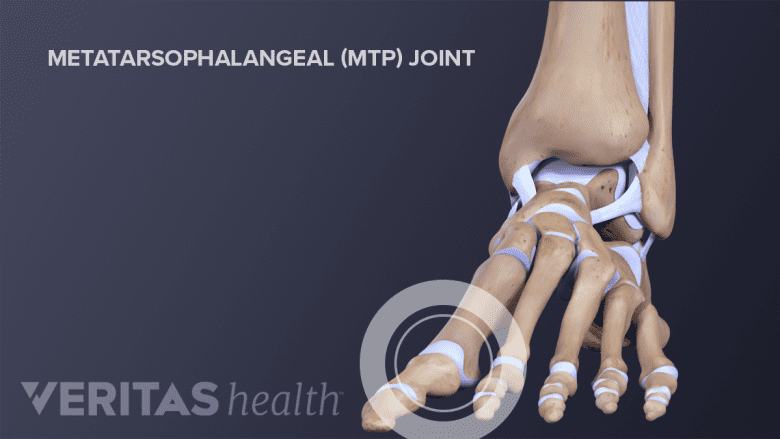Turf toe is a sprain to the metatarsophalangeal joint (MTP)—the largest joint in the big toe, which connects the first bone in the toe and the first long bone in the foot. When the MTP joint is injured or sprained, it can lead to varying degrees of pain, bruising, swelling, and sensitivity below the joint or at the ball of the foot.
The MTP and the other joint of the big toe, called the proximal interphalangeal joint (PIPJ), are supported and secured in place by the plantar complex, which consists of tissue, ligaments, a tendon, and small bones. Turf toe occurs when the big toe over-extends, injuring the soft tissue in the plantar complex.

Turf toe is a sprain to the metatarsophalangeal (MTP) joint.
In This Article:
- Turf Toe Injury (Metatarsophalangeal Joint Sprain)
- Turf Toe Symptoms
- Turf Toe Causes and Risk Factors
- Diagnosing Turf Toe
- Turf Toe Treatment
While turf toe is particularly prevalent among football athletes playing on artificial surfaces, this injury also impacts basketball, soccer, field hockey, and lacrosse players, as well as dancers.
Turf toe is also known by its medical name, first metatarsophalangeal joint sprain.
What Are the 3 Grades of Turf Toe Injuries?
The three grades of turf toe are based on severity:
Grade 1
This grade of turf toe is a minor injury involving a stretched plantar complex, with possible tenderness and swelling. Time-off from athletic participation is minimal: perhaps a few days of lighter workouts or rest. Failing to rest the MTP joint can make the injury worse.
Grade 2
The next level of turf toe causes moderate pain, diffuse tenderness, swelling, and bruising due to a partial tear in the plantar complex. A person’s regular activities are disrupted: symptoms magnify during the first 24 hours, joint movement is limited, and the person limps when weight is applied to the foot. Medical care is advised to make sure the injury is not more serious and to guide treatment. Physicians typically recommend taking about two weeks off from athletic activity in order to rest and heal.
Grade 3
The most serious turf toe injury results in a torn fully plantar complex. Severe pain is accompanied by acute swelling, bruising, and tenderness. The person is incapable of applying weight to the big toe. Urgent orthopaedic care is recommended, and a person may need several weeks of immobilization to heal.
During the past few years, turf toe injuries have increased.1McCormick, JJ, Anderson, RB. Turf Toe: Anatomy, Diagnosis, and Treatment. Sports Health. 2010; 2(6): 487-494. doi: 10.1177/1941738110386681. More awareness and early identification could be two reasons for this growth. The advent of lightweight, flexible shoes, and the increase in use of artificial surfaces are others.
- 1 McCormick, JJ, Anderson, RB. Turf Toe: Anatomy, Diagnosis, and Treatment. Sports Health. 2010; 2(6): 487-494. doi: 10.1177/1941738110386681.

